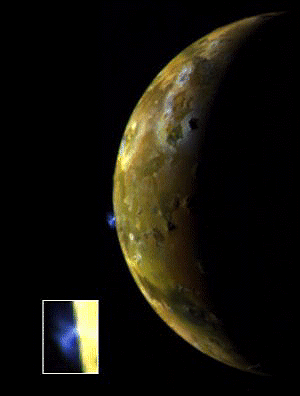
The largest planet in our solar system, Jupiter's size is sometimes hard for us to understand. The Great Red Spot, which is the oval-shaped feature near the bottom, right, is large enough to hold three Earths!

In the late 1970's NASA launched the two Voyager spacecraft. More than any other missions, these two explorers opened our eyes to our solar system. One of the many surprises the Voyager crafts found was a faint set of rings around Jupiter. Later in their missions, the space ships showed us that all the gas planets in our solar system have rings.

Another of the many surprises found by the Voyager missions was that Io has volcanoes like we do here on Earth. This picture, which created a lot of excitement when it was published, shows the pillar of hot gases that showed us where one of Io's many volcanoes was located.
Jupiter is the fifth planet from the Sun, located in between Mars and Saturn. Jupiter is the first gas planet in our solar system, as well as being the first of what are called the Outer Planets. It's average distance from the Sun is almost 470 million miles. Its orbit, or path it follows, around the sun is nearly a perfect circle. The closest it comes to the sun is about 460 million miles, and the furthest away it gets is a little over 500 million miles. A year on Jupiter is almost twelve Earth years! The giant planet's day is only about ten hours long, less than half as long as a Earth day.
When Jupiter is visible, it is usually the brightest star in the night sky. The only objects that are brighter is our Moon and Venus. There are times when you can see Jupiter in both the early morning and evening. Jupiter and its moons are so large that you can see the basic color of the giant planet with just a pair of binoculars. If you have patience, you can usually pick out one or more of the largest moons of Jupiter with your binoculars! After your eyes have had a minute or two to adjust to the light, you will see one or more small points of light. These lights will be a different color than the stars. Congratulations, you have found Jupiter's moons!
Jupiter is so large that it is hard for us to grasp just how big it is. Jupiter is over 85 thousand miles in diameter, dwarfing Earth, which is a little over 7,600 miles in diameter. Jupiter is so large that 1300 Earths could fit inside it! Put another way, if you had a ball that was about the size of a dime, Jupiter would be the size of a basketball!
The giant planet has at least sixteen moons, and possibly more. The four largest moons of the planet, called the Galilean moons. The two largest moons are both bigger than the planets Pluto and Mercury, and the largest of them is almost the size of Mars!
In addition to being very large, these four moons of Jupiter are also very interesting. Europa is a giant ball of ice. Io has active volcanoes! Io is the only place in the solar system besides Earth where we have found volcanoes. Callisto is covered with thousands of craters, which are the result of collisions with other objects in space. Ganymede, the largest moon, is made up of rocky ice.
The Romans named Jupiter after the supreme god in their religion. This is easy to understand, since it is the largest planet in the sky. Many of the planet's moons have been named for Jupiter's daughters.
As large as Jupiter is, it is not a rocky planet like Earth or Mars. Jupiter is a gas planet, which means that is not solid at all, but instead is a giant cloud made up mostly of the gas elements hydrogen and helium. Most things in the universe are not solid, but are giant balls or clouds of gas, and Jupiter is the same. Our Sun is a ball of gas that also gives us heat and light. What holds Jupiter together is the same as here on Earth, gravity.
Billions of years ago, Jupiter started forming when several clouds of gas began to accumulate in the same place. In much the same way that you build a ball of snow for a snowman, more and more clouds joined the crowd until the planet began to take shape. As the original ball of gas became bigger, it attracted, or gathered in, other clouds of gas. The larger the ball got, the planet's gravity, or force that attracted the other clouds, also grew. This continued until Jupiter grew to its present size.
Since Jupiter is a gas planet, it doesn't have a surface. This means that if you tried to land on the planet, you would not be able to find anything solid to land on. This does not mean that Jupiter does not have its own strange kind of "weather".
The clouds that make up Jupiter are constantly swirling around the planet, driven by winds that average over two hundred miles per hour. The winds create an ever-changing pattern of what we call storms on Earth. The most famous of these storms is the Great Red spot, which you can pick out in the picture of Jupiter at the top of the page.
Back To Main Menu
Use the "BACK" button on your Browser to return to the previous page.